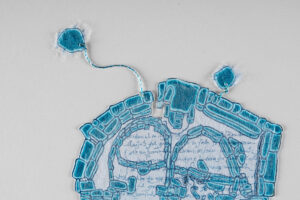
“Where I Hoped Rock Would Be” is a series of eighteen sewn-paper collages that draw on early modern palimpsests as models for inscription, erasure, and memory. The series belongs to a larger body of work based on archeological sites that have played strategic roles in the cultural crosscurrents of the Mediterranean Basin.
The building block is a drawing of Ħaġar Qim, a temple site located in Malta from a prehistoric civilization that existed between 3600 and 2500 BCE. Its footprint is collaged with colored pencil, ink, graphite, raw silk fabric, and a lithograph of the fifteenth century poem “Il-Kantilena” by Maltese poet Pietru Caxaro. Caxaro writes in a Semitic language that is a synthesis of late medieval Sicilian Arabic and Romance languages. Silk thread binds his astonishingly modern poem—addressing despair, resilience, impermanence, and the geographies of place and belonging—to its physical crossroads.